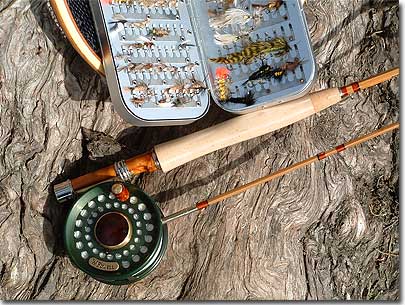Dan Fallon's August Fly Fishing Column
Dan Fallon's August Fly Fishing Column
By Dan Fallon
George Washington Dry Fly Master  One of my more infamous ancestors Phineous James O’Fallon was given the honor of being the father of our countries Quarter Master during the French and Indian war in the 1700s. One of my more infamous ancestors Phineous James O’Fallon was given the honor of being the father of our countries Quarter Master during the French and Indian war in the 1700s. After Edward Braddock was killed on the field of honor and George Washington was named Commander of all the Virginia forces, many days and nights were spent moving from one rural farm position to another. According to the letters and journals that survived until 1900 when my Grandfather was born, the General was already known as a consummate outdoors men and avid fly fishermen. On one particular chilly fall morning according to my Grand Dad, the men were about to cross a stream on property in eastern Ohio when General Washington stopped the march and summoned my fly fisher ancestor P.J. O’Fallon to assemble his favorite ** Manzanita 5 weight and tie on a #22 Mosquito the General tied the night before out of found Bald Eagle feathers. “ P.J. lets see if we can take a few of these fine rising trout before we stop for lunch, I want you to head down stream and splash around a bit and drive the fish up here for your Commander.” “ Yes sir, If I might make a small suggestion sir, that straight red manzanita can land anything this little ole stream can muster!”. Maybe let the fly dead drift with the current and I’ll try and scare em up to you sir.” * My understanding is old George caught the fly fishing bug from a visiting nephew of P.J. O’Fallon’s, Tom Fallon whose great grand son my great uncle Tom Fallon Adventurer is honored with a life size statue in San Jose California? The rest of the men pulled out their tobacco fixings and rolled or chewed while the father of our country played and landed five 15 inch or better trout that morning, according to my Grand Dad a fiddle player broke into *** “ Old Sue Zanna Don’t You Cry For Me “ and a gallon jug of rare Irish whiskey made the rounds... Of course Grand Dad was known to stretch the truth a taste when he had a taste or two! *** When exactly was that song written? Any body know? Before 1800s??? ** Only guessing on the type of fly rod, could have been solid Bamboo I presume? * San Jose California statue quite controversial as the adventurer was adventurous and said to be a distant relative of the Fallon Clan? Locals try and vote to have statue removed every so often, of course I’m quite proud of the old boy! ( Casual reading public beware this historically suspect anecdote is the first in likely a long series of historical illusions de grandeur...) Dry Fly Manifesto It is commonly understood it was first the British and later American Yankees like legendary Theodore Gordon ( 1854- 1915 ) and his adventures on fabled eastern waters like the Neversink that gave American fly fishing its beginning. The proto neo seminal “Quill Gordon “ remains an enigma to hard core dry fly sportsmen. Many of the earliest tales of dry fly daring- do include Colonel Ambrose Monell who was said to be among the first to catch a salmon on a dry fly in 1912. By the late 1920s perhaps less then 100 men were thought skilled dry fly fishermen, my own personal contact with people like the late great Bamboo Rod maker Walt Powell who dry fly fished with many American Presidents from Hoover to Jimmy Carter and movie stars was most fond of his best friends Bing Crosby, and Phil. Harris both consummate sportsmen dry fly fishers who he adventured with on the Fall River in Northern California. My own fond memories of meeting A.K.Best and Jay Fair both avid dry fly masters and legendary fly tiers is humbling. Personally I favor the theory my Irish ancestors educated the British first and that was the way fly fishing came to America, not via “ The Sun Never Sets On The Empire “ route. It was my fly fishy Irish country squires resplendent in high scholarly trout lore who first spread the good word to you the unwashed hordes! HOLY GRAIL BABY In the world of international fly fishing, dry fly techniques are most respected and coveted. The flies themselves: tiny Midges, caddis, mosquitos, black knats, Pale Morning Dun’s of many variety, Royal Coachmen, Black Coachmen, Adam’s Variant, Gunnison Trudes tied by Gretchen Beatty, Gale Doudy’s Gales Bug, SRI, Irresistible Wulff tied by Bill Black, A.K. Best Pale Morning Dunn, Jay Fair’s Mosquito, Walt Powell’s Double Humpy, Fletcher Quills Electric Trude, Cachibou Caddis by Craig Jansen, Gordon Quill by Karen Graham, Red Barron Salmon dry fly by Pudge kleinkuff, J.C. Caddis by Randy Stonebraker any dry fly tied by Jason Aki, Goddard October Caddis by Mark Hoeser, Spent Wing Caddis by Kieran Frye, Patriot Trude by Gretchen Beatty, Little Black Caddis by Jerry Caruso, Hot Creek Caddis by John Schaper, Kevin’s Caddis by Kevin McEnerney, legendary Northern California hatches featuring Callibaetis Dun’s by Craig Hull and of course up Fall River way Hexagenia exploding hatches like Chucks Hexagenia by Chuck Echer, Chain Stitched May Fly’s by Robert Williamson, Royal Lady by Ruth Zink, Quick nEasy by Gretchen Beatty Walt Powell’s Royal Trude , all the great Trudes like the Humpy Trude tied by Dave Borgas, anything tied by the noted steelhead woman’s fly fishing champion Dorothy Zinky.Last but not least any of the Historic celebrity collector sets tied with hair of famous historic figures like the American Music Trilogy set composed of a Black Knat tied with twenty-one year old Elvis jet black hair, The Palm Springs Silk Caddis tied with Frank Sinatra’s seventy year old hair, Al Jolsen dedicated Smokin Jolson Woolly tied with the twenty-five year old crooners hair into an excellent streamer. Contact Fletcher Quill for availability and current price list, bring a heavy checkbook... 3 Dry Fly Techniques Many methods exist and are tried and perfected in different climates with specific water considerations such as clarity, speed, depth, degree of above water structure, common hatches, level of trout higher education. My time ( all summer last year) on the fabled Fall River in upper California taught me the infamous Fall River Twitch, a technique where you shake out your fly line and let it dead drift down stream toward trout swimming in crystal clear waters, always downstream.  Hours at a time throwing light # 7 weight teppets four to six feet long so as to not scare the over educated wild Fall River strain of Rainbow. Strike indicators and very good vision and rod control were needed as one watched almost all fly line meander down stream until a take or running hit. I had moments when big trout hit and were hooked with only a few feet of backing left on the reel. On the one hand long casting skills did not apply, yet tying invisible #7 tippet that break easily offer great challenges to all fly fishers who learn the proper Twitch dead drift... High Sticking First perfected on the upstate New York small streams I fished in the early 1970s, later sharpened on the banks of Yosemite’s mighty Merced River while dangling from a tree limb and hovering over an area where several rising trout were trying to hit my #22 PMD bouncing and barely hitting the water as I high sticked the tiny fly up and down and all over catching many nice trout. If one comes upon an area where casting or wading or even roll casting or side arm casting won’t work? If the area has either high ledges, rock walls, hanging tree limbs? Simply climb up and let your line out until it hits the water, now watch how many trout you fool because they NEVER saw or worse heard your fly line come crashing down on their peaceful back water hide out DUDE!!!!!!! This is a pure can’t loose technique if done safely and carefully, I do not recommend serious tree climbing to anyone who knows the local Mc Donald Night manager’s family history if you get my pathetic super size me drift there cowboy!. I have caught many fish using this basically North American Indian fishing school of thought technique, go in peace ( safely) Pilgrim. Same old Same Old
“ Skill comes so slow, and life so fast doth fly, We learn so little and forget so much.
Sir John Davies 1569-1626 In the dusty ancient dry fly techniques library in the sky ( where” River Runs Through It”- runs endlessly) images of misty mornings where solitary male figures throw perfect long loops with delicate tiny flies that dead drift and are gently gulped by trout and set free fires the adventurus soul. Learning how to throw gentle wide loop casts that slowly, quietly move the air takes much practice and skill. Many once or twice a year fly fishers cannot do this quiet casting effectively. Practice and more practice watching your back cast completely unfold and then applying just enough energy to propel the line airborne. It takes more than two or three fly trips a year, but it can be learned and the complete fly fisher has mastered line control and all its sub levels with practice. Dry fly presentation techniques are learned slowly with an eye toward one day understanding how less energy expanded in first false casts can result in just enough forward line propulsion to resemble a graceful swan landing on water like glass... It is this hard set of dry fly fishing rules or unspoken hypotheses that make this sport the most complicated, most thought provoking sport available other than Chess perhaps... In this school of fly fishing, long distance is a must and the sooner you learn to throw over 70 feet with accuracy in light wind situations, the quicker and less daunting the idea of actually learning stream current identification, insect hatches, water temperature variables, how to wade safely in fast cold water, and of course how exactly to tie these tiny bugs? It is the minimum required base knowledge needed to begin your dry fly learning journey here in the land of the feather insect makers, watch, listen, read and maybe you will learn what few have ever really learned or rarely master. Ever region world wide has its own dry fly techniques based loosely on the above three concepts. In my mind one can never stop looking or asking about local dry fly techniques, when I first arrive in any new fly waters asking local fly shop owners and local fly fishers pattern /technique questions is step one. Buying several local patterns and not being shy about asking questions or walking into a local Pub or Bar and buying single malts for the guy who knows his home waters like the back of his hand is the way to go sports fan.  Click Here for this month's story line of Click Here for this month's story line of “ ADVENTURES OF FLETCHER QUILL “
|
